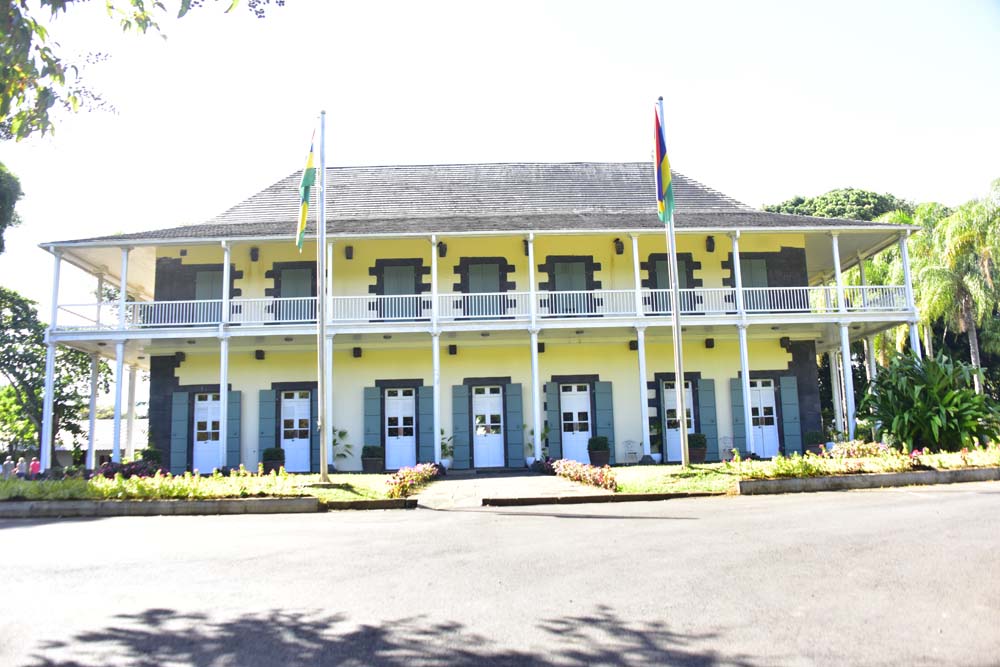
The Chateau Mon Plaisir
This two-storeyed building is not the fine house built by Labourdonnais near the main gate. After Governor David deserted Mon Plaisir for Le Reduit in 1746, it was later occupied by the new Intendant, Pierre Poivre. But Governor Labrillanne objected to this and at the request of Nicolas Céré, a building with a flat roof was erected for the Intendant in 1777. This building no longer exists.
After the British conquest of the island in 1810, a new building was constructed in 1823, as it stands today.
From the Château one has an attractive view of the Moka Range and the peak of Pieter Both. The building is today protected by law and has been proclaimed National Heritage.
It is proposed to set up an interactive museum, a conference room and an exhibition of botanical interest on the ground floor of the Château.

The Garden also houses two funerary monuments of the first two Prime Ministers of Mauritius: the Sir Seewoosagur Ramgoolam Samadhi and Memorial and the Sir Anerood Jugnauth Samadhi and Memorial.
Sir Seewoosagur Ramgoolam Samadhi and Memorial
Sir Seewoosagur Ramgoolam (1900-1985) was born in the village of Belle Rive. He studied medicine at University College, London. He joined politics in the mid-1930s. He was the leading figure in the movement demanding an end to British colonial rule in Mauritius and became the first Prime Minister of Mauritius after its independence in 1968. In 1983 he became Governor General and passed away at Le Réduit in 1985. Sir Seewoosagur Ramgoolam received a national funeral. He was cremated at Sir Seewoosagur Ramgoolam Botanic garden where his Samadhi has been erected.
Officials and friends pay homage to this distinguished countryman by laying wreaths on the Samadhi as a mark of respect. The Sir Seewoosagur Ramgoolam Memorial consists of a fountain feature surmounted by a sculpture of a lotus flower (Nelumbo nucifera) in basalt, with the inscription ‘In beloved memory of the Father of the Nation’ in front. This was designed by the well-known Mauritian artist and architect, Marcel Lagesse.
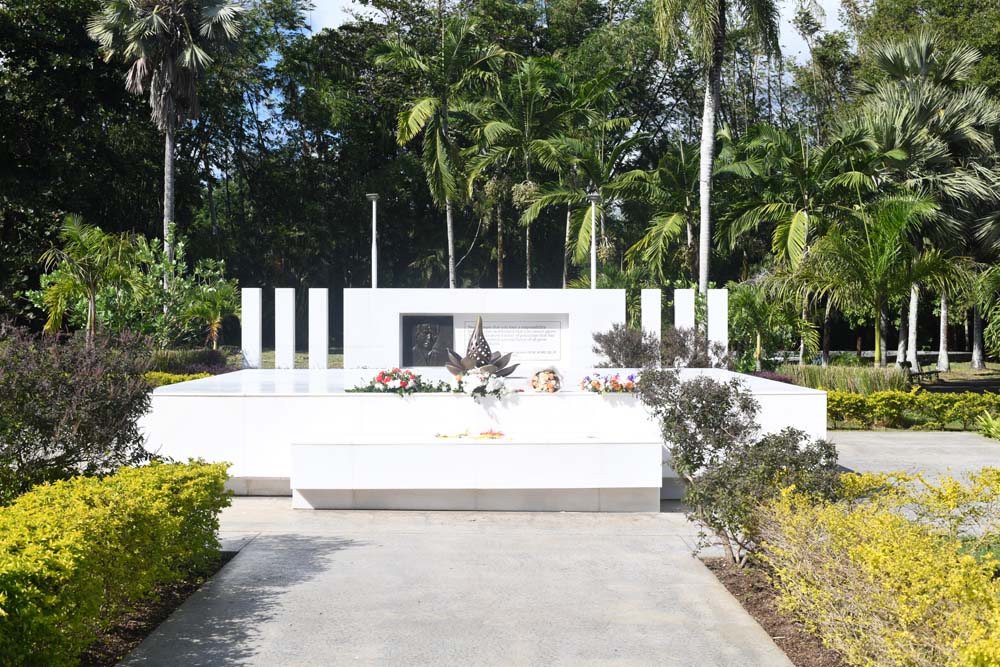
Sir Anerood Jugnauth Samadhi and Memorial
Sir Anerood Jugnauth (1930-2021) was born in the village of Palma. He trained as a lawyer and became one of the most remarkable and respected politicians of the country by serving twice as President of the Republic, and six times as Prime Minister. He passed away on 3 June 2021 at the age of 91.
To mark the first anniversary of the death of Sir Anerood Jugnauth the Ministry of Arts and Cultural Heritage inaugurated a Samadhi and a memorial at the Garden. It was accompanied by a symbolic planting of a Rudraksha tree by the serving Prime Minister. Originally from the Elaeocarpaceae family, the tree’s beads are known for its healing properties.
A photo exhibition retracing the highlights of the personal life and achievements of Sir Anerood Jugnauth was also organised at the Château Mon Plaisir.
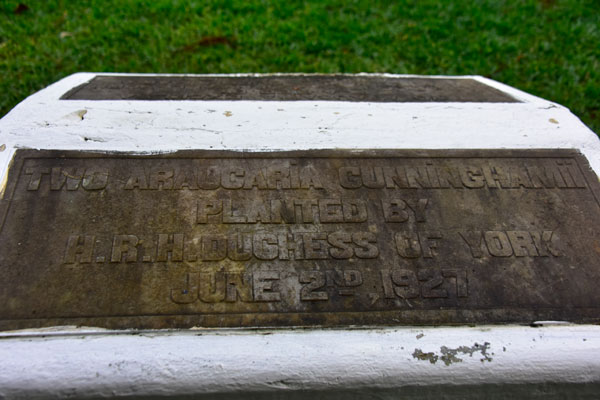
HRH Duchess of Cornwall and York plaque (1901) and the HRH Duchess of York plaque (1927)
The Royal Family’s visits to Mauritius and to the Botanic Garden was remembered by the laying of bronze plaques and planting of trees.
The plaque commemorating the visit of HRH Duchess of Cornwall and York was laid on 7th August 1901 and two Araucaria excelsa were planted.
On the occasion of the visit of HRH the Duchess of York (Queen Elizabeth) on 2nd June 1927, a plaque was laid on 2nd June 1927 and two Araucaria cunninghamii were planted.
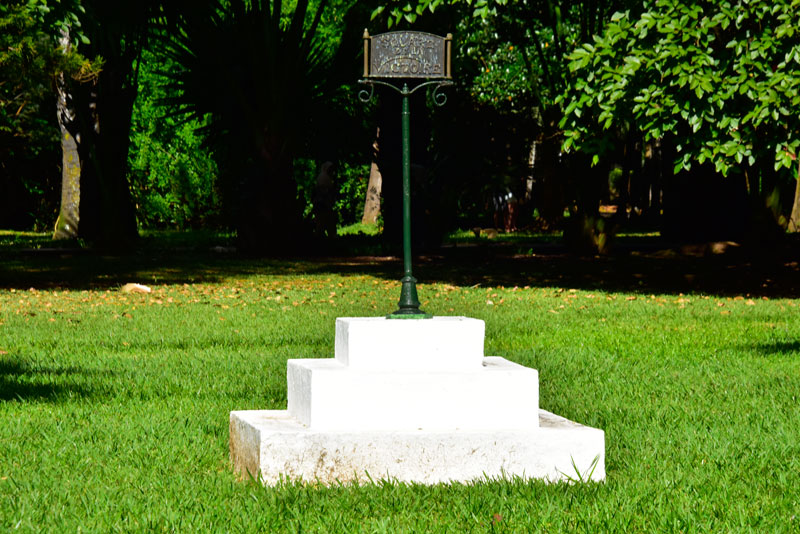
Place de la Victoire
This very simple monument, mounted with a cross was placed on 3rd August 1919 to mark the Allies Victory in the First World War (1914-1918).

Stanley Alexander de Smith Monument
This monument is dedicated to one of the drafters of the Constitution of Mauritius, Professor Stanley Alexander de Smith, Cambridge University. He had expressed the wish for his ashes to be dispersed in Mauritius.

Old Sugar Mill
The old sugar mills in Mauritius were not powered with motors; the vertical rollers which crushed the canes were rotated by two oxen. In modern mills there are several sets of horizontal cylinders to ensure that all juice in the canes has been nearly completely expressed. In the old days, however, millers had to be content with a single press. The juice was collected in a pond which in this case is found under the straw roof and from there, led into a set of five cauldrons, the first two of which were not heated. Foreign matter was skimmed off before the juice was “cooked” to the consistency of caramel. This syrup was then given time to set in the tray nearby where it was shaped in wooden moulds. However simple this mill may appear to be, it satisfied the needs of the time. In the years that followed, steady progress was made in the crushing and processing of cane, all of which has led to the modern highly sophisticated mills.
The old sugar mill was donated to the Garden in 1953 by the Mauritius Chamber of Agriculture to mark its centenary of its creation. The Mill was renovated by Alteo Limited in 2024.
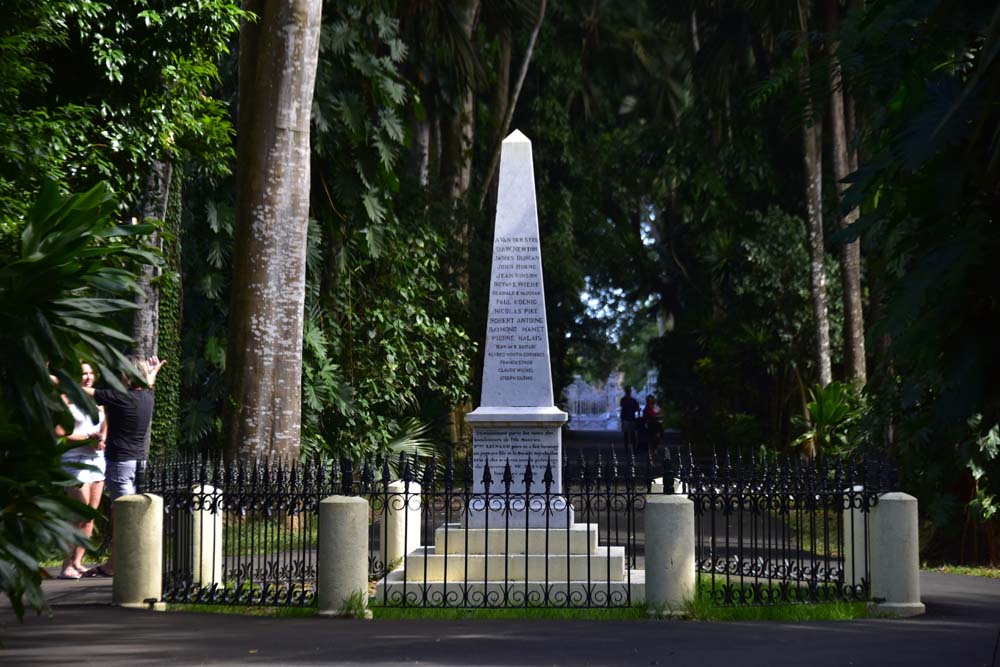
Liénard Obelisk
Turning left on Labourdonnais Avenue which is flanked with the fairly rare yellow latan (Latania sp.) from Madagascar, one encounters the Liénard Obelisk. The latter is a graceful, white column of marble donated by François Liénard de la Mivoye (1782-1861) to the Royal Society of Arts and Sciences of Mauritius and placed in the Garden under the patronage of Governor William Stevenson in 1861. On one side of the monument is inscribed this philosophical saying from Bernardin de Saint Pierre:
“Le don d’une plante utile me parait plus précieux que la découverte d’une mine d’or et un monument plus durable qu’une pyramide”
According to the wishes of Liénard, the names of those who have contributed to the prosperity of the island by helping its agriculture or by introducing interesting plants or animals are engraved on the marble. The first name to appear on the column is that of Mahé de Labourdonnais. In June 2007, three names were engraved: those of Professor Robert Antoine, Dr. Raymond Mamet and Dr. Pierre Halais. The last inscriptions were of Jean de Boucherville Baissac, Alfred North Coombes, France Staub, Claude Michel and Joseph Guého on 31st October 2019.
There are in total seventy three names engraved on the Obelisk.
Traditionally, as per the will of Liénard, a name can be engraved not less than 10 years after the passing away of the person concerned.
